Yes, I totally took the idea of titling this blog from the vlogbrothers. They sometimes do a segment called “Thoughts from Places,” where they record what they did at a particular location and then reflect on what they had experienced.
I intend on doing the same here.
Last week, I went to the Toledo Museum of Art to check out the exhibition of Frank Stella’s Irregular Polygons. It was at this exhibition that I first came across the idea of an artist making things for the logic of it, and for utilizing their functional brains and showing it. In other words, thinking over feeling.
I had never thought about making art as a process of thinking over feeling. I was under the assumption that the arts existed to show emotions of the user. Thinking about it, though, I could maybe understand the idea of art showing the results of logical experimentation, over showing the results of spontaneity.
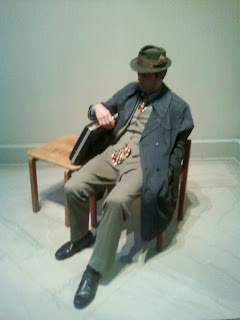 |
| This is a sculpture. It freaks me the f**k out how realistic this is. My friend Ben and I thought he was actually asleep. |
Sometimes art could be like a scientific experiment: you play with materials to see the outcome of it, without putting emotion into it. Or it would be more like testing an idea before making it a final image.
But when does a test become art? And why would it be called art? The common man assumption is that art is an expression of creativity, but these experiments in materials and logic seem to go against that definition. Logic is not creative, according to this idea.
In the art world, I’ve noticed, we don’t use the everyday-man definition. We, being artists, made one up.
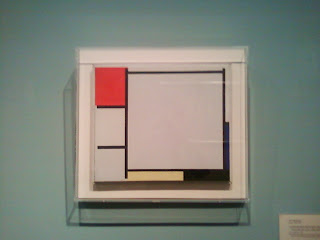 |
| I’m so glad I could see this original by Piet Mondrian. It’s better to see in person than in pictures. |
The definition of art, to my understanding of how academia sees it, is an expression of the artist’s mind. Whether that mind be logical or emotional, that’s up to them.
Does this mean logical art wins over emotional art? Depends on who you ask. If you ask me, I say both have their pluses and minuses. Art that uses the creator’s logic can lend itself to breaking the formal rules of the art world. Art of logic doesn’t have to be representational (that is, look like something that already exists) and it doesn’t have to represent just one idea.
 |
| A Frank Stella original. I believe this was made after the Irregular Polygon series. And it’s humongous. |
The cool thing about logic-based art is that it can open up the mind to play with those same principals that are being broken.
The problem is that most people don’t know what those principals are.
Not that art based in emotion answers those questions, either: they can break the rules, as well, but usually it’s done on the artist’s whim and personal expression. It wouldn’t necessarily be based on playing with formulas to stimulate their functional parts of the brain.
For the emotional artist, art exists to express ideas they feel in those moments, ideas that are based on their perceptions and feelings. Logic often doesn’t come in at all.
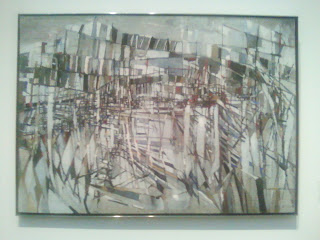 |
| This piece was titled something like “City Scape”, though I feel like it looks over a harbor of boats. |
As can be noted in the caption for the picture above, the artist that uses emotions willingly lets their pieces be open to interpretation for the patron. For many of them, it’s not about, “This is my idea, do not deviate from this idea.” It’s more about letting the viewer make up their own meaning.
This goes against the logical artist because the logical one makes things and just lets them be. They often don’t have some kind of emotional message to the work.
Another thing that can be noted for the logical artist is that sometimes their pieces can be functional.
 |
| This is a bank teller’s gate. The photo can’t capture it’s intense level of detail. |
The bank teller’s gate, above, is a good example of this. The enormous bronze doors shown at the Carnegie Museum of Art are another.
Can logic and emotion combine into one art piece? Sure. After all, art is an expression of the artist’s mind. An art piece can be both logical and satisfy the artist’s left brain and be emotional and satisfy the right brain. Rules can be played with and emotions can be displayed.
 |
| This Grecian vase, besides being lavishly detailed, is both functional/logical and emotional. |
The Greeks and Egyptians did that a lot, but especially the Greeks: they were obsessed with the Golden Ratio and mathematical formulas, so their vases and other forms of art would fit into these logical molds. But then they could be decorated with stories, which are more whimsical and emotional. In this way, Greeks satisfied both parts of their brain, the left and right side.
Personally, I always go towards the emotional art: they, more often than not have stories behind them. They can also portray the artist’s life circumstances of that moment.
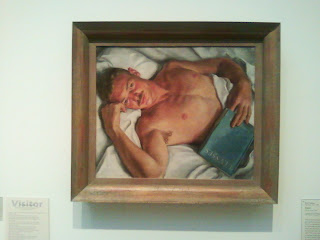 |
| This is a painting of the artist’s male lover. It has both story and tenderness to it. |
Logic-based art is something I can respect, and understand a little bit, but it’s not something I would like to do. My brain is logical, sure, but that doesn’t mean I can understand the other artist’s logic.
 |
| I have no idea what this is suppose to be. |
If you’ve noticed, art within the last century has been shifting from being based on emotions and stories to being based on logic and the creator’s thought processes. I don’t know if this is a bad move, but I think that can explain why I don’t understand modern art at all. There are times that I just can’t understand the artists themselves. And if you can’t understand the artist, you can’t understand the artwork they’ve made.
What do you guys think? Let me know in the comments below.
Also, sorry this entry was OBSCENELY long, but there were so many ideas I wanted to get off my chest. Keep your eyes open for another blog update in the next couple of days. ;D
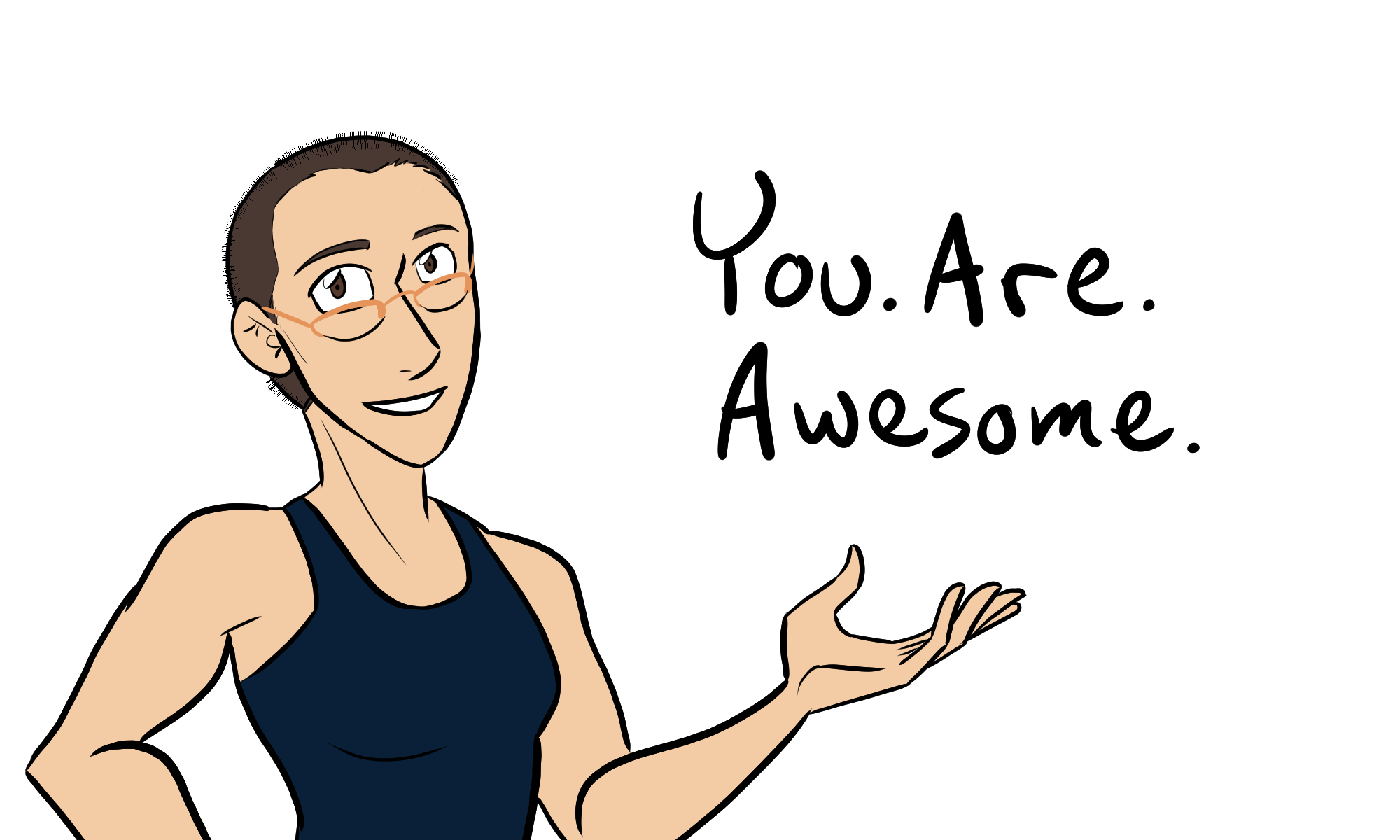
I actually believe (coming up on graduating from the BFA program in 2 weeks) that instead of using the “logical” point of view, rather , consider “conceptual” instead. That perspective opens up another whole can of worms… because I agree, art has been moving more into that direction in recent history and in contemporary practices. Art itself has meaning beyond the simple object. It’s almost as if the idea is more important than the actual work of art itself. It’s more about the questions that art poses as opposed to it’s actual functionality in the world. It’s function is to question. Conceptual art can be either “logical” with I’ve equated to “highly conceptual” and very abstracted, whether it’s minimalism or heavy painterly abstraction but in that logic, I believe, emotion will always be present… even if the emotion is no emotion. Does that make sense?
There’s a good reason for this shift I believe too. With technology and the lack of need for artists to be “portrait painters” or sculptors or even inventors, what else are we left with? What other reason can we justify our existence. Some artists can still make it as portrait painters (Very, very few) and some because illustrators, or commercial artists… but other than that… the role of art being art for the sake of art is a much harder path to gain respect in, so the work must question a lot. It can’t just be the same thing done the same way as it has been for hundreds of years. This forces people out onto a limb, and I come to find, the longer you spend with contemporary art/modern art, the more you’ll come to understand it and appreciate it. (I came from a like opinion to your own.) You won’t necessarily like the aesthetic, but you’ll appreciate nonetheless, and hopefully it will be some sort of intrigue for you… it will have you asking yourself that most immanent question: why?
I hope this all makes sense. I jumped around a lot. If you get the chance to see new exhibitions (and not just stuff from modernism and post-modernism that’s on permanent collection in most museums) I think you’ll find contemporary art to be much more exciting. Anything goes! Which means, you’re bound to find something you like!
Wow, so many typos… my apologies… I’m normally a lot more with it than that…
Lol, it’s ok. I can still understand your argument.
And I had an answer typed up and ready, and then the computer glitched and lost it, so I’ll type it up as best as I can according to memory.
I definitely appreciated it when you said, “It’s almost as if the idea is more important than the actual work of art itself. It’s more about the questions that art poses as opposed to it’s actual functionality in the world. It’s function is to question.” I think up to this point, art existed to answer questions: What does the world look like? Who’s Mona Lisa? What happened on May 8, 1865? and so on. But now contemporary art poses questions instead of answering them. If it hasn’t caused a paradigm shift already, I can see it making one.
However, I don’t think art is either/or. I think both contemporary and traditional art will still coexist. Contemporary art can pose the questions for traditional art to try and answer, which in turn makes contemporary art ask more questions, and the cycle continues.